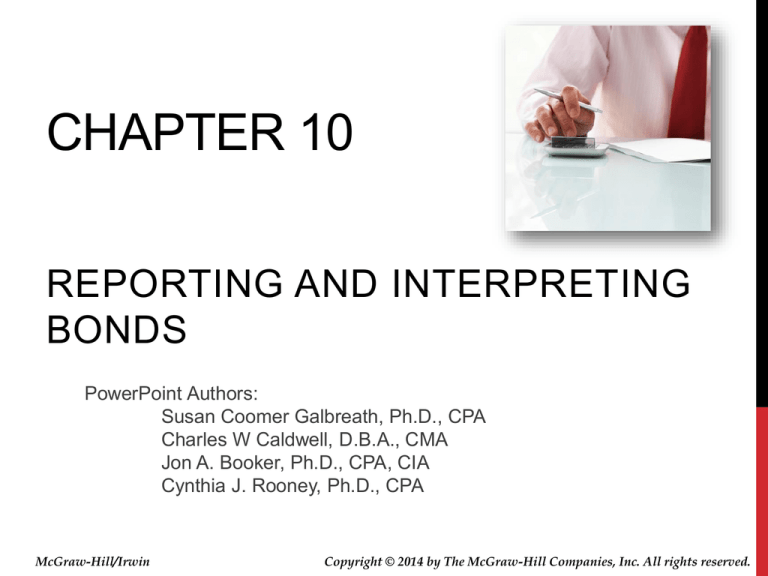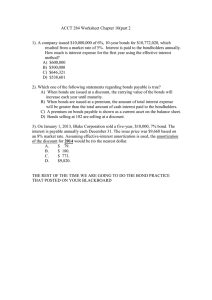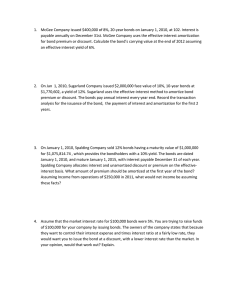
CHAPTER 10
REPORTING AND INTERPRETING
BONDS
PowerPoint Authors:
Susan Coomer Galbreath, Ph.D., CPA
Charles W Caldwell, D.B.A., CMA
Jon A. Booker, Ph.D., CPA, CIA
Cynthia J. Rooney, Ph.D., CPA
McGraw-Hill/Irwin
Copyright © 2014 by The McGraw-Hill Companies, Inc. All rights reserved.
UNDERSTANDING THE BUSINESS
The mixture of debt and equity used to finance a
company’s operations is called the capital structure.
Debt - funds
from creditors
Equity - funds
from owners
10-2
CHARACTERISTICS OF BONDS
PAYABLE
Advantages of bonds:
• Stockholders maintain
control because bonds
are debt, not equity.
• Interest expense is tax
deductible.
• The impact on earnings is
positive because money
can often be borrowed at
a low interest rate and
invested at a higher
interest rate.
Disadvantages of bonds:
• Risk of bankruptcy exists
because the interest and
debt must be paid back as
scheduled or creditors will
force legal action.
• Negative impact on cash
flows exists because
interest and principal must
be repaid in the future.
10-3
CHARACTERISTICS OF BONDS
PAYABLE
Two types of cash payment in the bond contract:
1. Principal.
2. Cash interest payments.
Bond Terms
1. Principal, par value and face
value
2. Contract, stated, or coupon
rate of interest
3. Market, yield, or effectiveinterest rate
10-4
CHARACTERISTICS OF BONDS
PAYABLE
An indenture is a bond contract that
specifies the legal provisions of a
bond issue.
Unsecured (debenture) bonds
No assets are pledged as guarantee of repayment at maturity.
Secured bonds
Specific assets are pledged as guarantee of repayment at
maturity.
Callable bonds
Bond may be called for early retirement by the issuer.
Convertible bonds
Bond may be converted to other securities (usually common stock).
10-5
CHARACTERISTICS OF BONDS
PAYABLE
• The bond indenture contains
covenants designed to protect
the creditors.
• The bond issuer also prepares a
prospectus, which describes the
company, the bonds, and how the
proceeds of the bonds will be
used.
• The trustee makes sure the
issuer fulfills all of the provisions
of the bond indenture.
10-6
REPORTING BOND TRANSACTIONS
Present Value of the Principal (a single payment)
+ Present Value of the Interest Payments (an annuity)
= Issue Price of the Bond
Interest
Rates
Bond
Price
Stated
Rate
=
Market Bond
Par Value
=
Rate Price
of the Bond
Stated
Rate
< Market Bond <
Stated
Rate
> Market Bond >
Rate
Rate
Price
Price
Accounting for
the Difference
There is no difference
to account for.
Par Value
of the Bond
The difference is accounted
for as a bond discount.
Par Value
of the Bond
The difference is accounted
for as a bond premium.
10-7
BONDS ISSUED AT PAR
On January 1, 2014, AT&T issues $100,000 in
bonds having 10% annual stated rate of interest.
The bonds mature in 2 years and interest is paid
semiannually. The market rate is 10% annually.
Interest
Rates
Bond
Price
Accounting for
the Difference
This bond is issued at a par.
Stated
Market Bond
Par Value
=
=
Rate
Rate Price
of the Bond
There is no difference
to account for.
GENERAL JOURNAL
Date
Jan
1
Description
Cash (+A)
Bonds Payable (+L)
Debit
Credit
100,000
100,000
10-8
BONDS ISSUED AT PAR
Here is the entry made every six months to record the
interest payment.
GENERAL JOURNAL
Date
Description
Bond Interest Expense (+E, -SE)
Cash (-A)
Debit
Credit
5,000
5,000
Here is the entry to record the maturity of the bonds.
GENERAL JOURNAL
Date
Description
Bonds Payable (-L)
Cash (-A)
Debit
Credit
100,000
100,000
10-9
TIMES INTEREST EARNED
Times Interest
=
Earned
Net income + Interest expense
+ Income tax expense
Interest expense
The ratio shows the amount of resources
generated for each dollar of interest
expense. In general, a high ratio is viewed
more favorably than a low ratio.
10-10
BONDS ISSUED AT DISCOUNT
On January 1, 2014, AT&T issues $100,000 in bonds
having a 10% annual stated rate of interest. The
bonds mature in 2 years (Dec. 31, 2015) and interest
is paid semiannually. The annual market rate of
interest is 12%.
This bond is issued at a discount.
Interest
Rates
Bond
Price
Accounting for
the Difference
Stated
Market Bond
Par Value The difference is accounted
<
<
Rate
Rate Price
of the Bond
for as a bond discount.
10-11
BONDS ISSUED AT DISCOUNT
The issue price of a bond is
composed of the present value
of two items:
•Principal (a single amount)
•Interest (an annuity)
First, compute
the present
value of the
principal.
Market rate of 12% ÷ 2 interest periods per year = 6%
Bond term of 2 years × 2 periods per year = 4 periods
Present Value
Single Amount =
$
79,210 =
Principal
$ 100,000
× Factor (i=6.0% , n=4)
× 0.7921
10-12
BONDS ISSUED AT DISCOUNT
The issue price of a bond is
composed of the present value
of two items:
•Principal (a single amount)
•Interest (an annuity)
Now, compute
the present
value of the
interest.
Market rate of 12% ÷ 2 interest periods per year = 6%
Bond term of 2 years × 2 periods per year = 4 periods
Present Value
Annuity
=
$
17,326 =
Payment
$
5,000
× Factor
× 3.4651
(i=6.0% , n=4)
10-13
BONDS ISSUED AT DISCOUNT
The issue price of a bond is
composed of the present value
of two items:
•Principal (a single amount)
•Interest (an annuity)
$
+
= $
Finally,
determine the
issue price of
the bond.
79,210 Present Value of the Principal
17,326 Present Value of the Interest
96,536 Present Value of the Bonds
The $96,536 is less than the face amount of $100,000, so the
bonds are issued at a discount of $3,464.
10-14
BONDS ISSUED AT DISCOUNT
Here is the journal entry to record the
bonds issued at a discount.
GENERAL JOURNAL
Date
Jan
Description
1 Cash (+A)
Discount on Bonds Payable (+XL, -L)
Bonds Payable (+L)
Debit
Credit
96,536
3,464
100,000
This is a contra-liability account that appears in
the liability section of the balance sheet.
10-15
BONDS ISSUED AT DISCOUNT
AT&T
Partial Balance Sheet
At January 1, 2014
Long-Term Liabilities
Bonds Payable, 10%
Due Dec. 31, 2015
Less: Bond Discount
Total L-T Liabilities
$
$
100,000
(3,464)
96,536
The discount
will be
amortized
over the
2-year life of
the bonds.
Two methods of amortization are commonly used:
Straight-line
Effective-interest
10-16
REPORTING INTEREST EXPENSE:
STRAIGHT-LINE AMORTIZATION
Identify the amount of the
bond discount.
Divide the bond discount by
the number of interest
periods.
Include the discount
amortization amount as part
of the periodic interest
expense entry.
The discount will be reduced
to zero by the maturity date.
10-17
REPORTING INTEREST EXPENSE:
STRAIGHT-LINE AMORTIZATION
AT&T issued their bonds on Jan. 1, 2014. The
discount was $3,464. The bonds have a 2-year
maturity and $5,000 interest is paid semiannually.
Compute the periodic discount amortization
using the straight-line method.
Discount
Amortization
$
866
=
=
Total
Discount
$
3,464
Number of
÷ Interest Periods
÷ 4
10-18
REPORTING INTEREST EXPENSE:
STRAIGHT-LINE AMORTIZATION
GENERAL JOURNAL
Date
Jun
Description
Debit
30 Interest Expense (+E, -SE)
Discount on Bonds Payable (-XL, +L)
Cash (-A)
AT&T
Partial Balance Sheet
At June 30, 2014
Long-Term Liabilities
Bonds Payable, 10%
Due Dec. 31, 2015
Less: Bond Discount
Total L-T Liabilities
$
$
100,000
(2,598)
97,402
Credit
5,866
866
5,000
As the discount
is amortized,
the carrying
amount of the
bonds
increases.
10-19
REPORTING INTEREST EXPENSE:
STRAIGHT-LINE AMORTIZATION
An amortization table illustrates the interest payment, interest
expense, discount amortization, unamortized discount balance,
and the carrying value of the bond for each interest payment
period over the life of the bond.
Date
1/1/2014
6/30/2014
12/31/2014
6/30/2015
12/31/2015
Straight-Line Amortization Table
Interest
Interest
Discount Unamortized
Book
Payment Expense Amortization Discount
Value
$
3,464 $ 96,536
$ 5,000 $ 5,866 $
866
2,598
97,402
5,000
5,866
866
1,732
98,268
5,000
5,866
866
866
99,134
5,000
5,866
866
100,000
10-20
REPORTING INTEREST EXPENSE:
EFFECTIVE-INTEREST AMORTIZATION
The effective interest method
is the theoretically preferred
method.
Compute interest expense by
multiplying the current unpaid
balance times the market rate
of interest.
The discount amortization is
the difference between the
calculated interest expense
and the cash paid (or accrued)
for interest.
10-21
REPORTING INTEREST EXPENSE:
EFFECTIVE-INTEREST AMORTIZATION
AT&T issued their bonds on Jan. 1, 2014. The issue
price was $96,536. The bonds have a 2-year maturity
and $5,000 interest is paid semiannually.
Compute the periodic discount amortization using
the effective interest method.
Unpaid Balance × Effective Interest Rate × n/12
$96,536 × 12% × 6/12 = $5,792
Discount
Amortization
$
792
=
=
Total
Interest
$
5,792
-
Cash Paid
for Interest
$
5,000
10-22
REPORTING INTEREST EXPENSE:
EFFECTIVE-INTEREST AMORTIZATION
GENERAL JOURNAL
Date
Description
Debit
Jun 30 Interest Expense (+E, -SE)
5,792
Discount on Bonds Payable (-XL, +L)
Cash (-A)
AT&T
Partial Balance Sheet
At June 30, 2014
Long-Term Liabilities
Bonds Payable, 10%
Due Dec. 31, 2015
Less: Bond Discount
Total L-T Liabilities
$
$
100,000
(2,672)
97,328
Credit
792
5,000
As the discount
is amortized,
the carrying
amount of the
bonds
increases.
10-23
REPORTING INTEREST EXPENSE:
EFFECTIVE-INTEREST AMORTIZATION
Notice that for the effective-interest method, the amount of
interest expense and discount amortization varies each
period, unlike under the straight-line method where these
were the same each period.
Date
1/1/2014
6/30/2014
12/31/2014
6/30/2015
12/31/2015
Effective-Interest Amortization Table
Interest
Interest
Discount Unamortized
Book
Payment Expense Amortization* Discount
Value
$
3,464 $ 96,536
$ 5,000 $ 5,792 $
792
2,672
97,328
5,000
5,840
840
1,832
98,168
5,000
5,890
890
942
99,058
5,000
5,943
942 *
100,000
* Equals remaining unamortized discount.
10-24
ZERO COUPON BONDS
Zero coupon bonds do not pay
periodic interest.
Because there is no interest annuity, the
PV of the Principal = Issue Price of the Bonds
This is called a deep discount
bond.
10-25
BONDS ISSUED AT PREMIUM
On January 1, 2014, AT&T issues $100,000 in bonds
having a 10% annual stated rate of interest. The
bonds mature in 2 years (Dec. 31, 2015) and interest
is paid semiannually. The annual market rate of
interest is 8%.
This bond is issued at a premium.
Interest
Rates
Bond
Price
Accounting for
the Difference
Stated > Market Bond > Par Value The difference is accounted
Rate
Rate Price
of the Bond
for as a bond premium.
10-26
BONDS ISSUED AT PREMIUM
The issue price of a bond is
composed of the present value
of two items:
•Principal (a single amount)
•Interest (an annuity)
First, compute
the present
value of the
principal.
Market rate of 8% ÷ 2 interest periods per year = 4%
Bond term of 2 years × 2 periods per year = 4 periods
Present Value
Single Amount =
$
85,480 =
Principal
$ 100,000
× Factor (i=4.0% , n=4)
× 0.8548
10-27
BONDS ISSUED AT PREMIUM
The issue price of a bond is
composed of the present value
of two items:
•Principal (a single amount)
•Interest (an annuity)
Now, compute
the present
value of the
interest.
Market rate of 8% ÷ 2 interest periods per year = 4%
Bond term of 2 years × 2 periods per year = 4 periods
Present Value
Annuity
=
$
18,150 =
Payment
$
5,000
× Factor
× 3.6299
(i=4.0% , n=4)
10-28
BONDS ISSUED AT PREMIUM
The issue price of a bond is
composed of the present value
of two items:
•Principal (a single amount)
•Interest (an annuity)
$
+
= $
Finally,
determine the
issue price of
the bond.
85,480 Present Value of the Principal
18,150 Present Value of the Interest
103,630 Present Value of the Bonds
The $103,630 is greater than the face amount of $100,000,
so the bonds are issued at a premium of $3,630.
10-29
BONDS ISSUED AT PREMIUM
GENERAL JOURNAL
Date
Jan
Description
Debit
1 Cash (+A)
Premium on Bonds Payable (+L)
Bonds Payable (+L)
ST&T
Partial Balance Sheet
At January 1, 2014
Long-Term Liabilities
Bonds Payable, 10%
Due Dec. 31, 2015
Add: Bond Premium
Total L-T Liabilities
$
100,000
$
3,630
103,630
Credit
103,630
3,630
100,000
The premium
will be
amortized
over the
2-year life of
the bonds.
10-30
REPORTING INTEREST EXPENSE:
STRAIGHT-LINE AMORTIZATION
An amortization table illustrates the interest payment, interest
expense, premium amortization, unamortized premium balance,
and the carrying value of the bond for each interest payment
period over the life of the bond.
Date
1/1/2014
6/30/2014
12/31/2014
6/30/2015
12/31/2015
Straight-Line Amortization Table
Interest
Interest
Premium Unamortized
Book
Payment Expense* Amortization* Premium
Value
$
3,630 $ 103,630
$ 5,000 $ 4,092 $
908
2,723
102,723
5,000
4,092
908
1,815
101,815
5,000
4,092
908
908
100,908
5,000
4,092
908
100,000
* Rounded.
10-31
REPORTING INTEREST EXPENSE:
STRAIGHT-LINE AMORTIZATION
Here is the journal entry to record the payment of
interest and the premium amortization every six
months using the straight-line amortization method.
GENERAL JOURNAL
Date
Description
Interest Expense (+E, -SE)
Premium on Bonds Payable (-L)
Cash (-A)
Debit
Credit
4,092
908
5,000
10-32
REPORTING INTEREST EXPENSE:
EFFECTIVE-INTEREST AMORTIZATION
Notice that for the effective-interest method, the amount of
interest expense and premium amortization varies each
period, unlike under the straight-line method where these
were the same each period.
Date
1/1/2014
6/30/2014
12/31/2014
6/30/2015
12/31/2015
Effective-Interest Amortization Table
Interest
Interest
Premium Unamortized
Book
Payment Expense* Amortization* Premium*
Value
$
3,630 $ 103,630
$ 5,000 $ 4,145 $
855
2,775
102,775
5,000
4,111
889
1,886
101,886
5,000
4,075
925
961
100,961
5,000
4,039 *
961
100,000
* Rounded.
10-33
REPORTING INTEREST EXPENSE:
EFFECTIVE-INTEREST AMORTIZATION
Here is the journal entry to record the payment
of interest and the premium amortization for
the six months ending on June 30, 2014.
GENERAL JOURNAL
Date
Description
Jun 30 Interest Expense (+E, -SE)
Premium on Bonds Payable (-L)
Cash (-A)
Debit
Credit
4,145
855
5,000
10-34
DEBT-TO-EQUITY
Debt-to-Equity
=
Total Liabilities
Stockholders’ Equity
This ratio shows the relationship between
the amount of capital provided by owners
and the amount provided by creditors. In
general, a high ratio suggest that a
company relies heavily on funds provided
by creditors.
10-35
EARLY RETIREMENT OF DEBT
Occasionally, the issuing
company will call (repay early)
some or all of its bonds.
Gains/losses are calculated by
comparing the bond call
amount with the book value of
the bond.
Book Value > Retirement Price = Gain
Book Value < Retirement Price = Loss
10-36
EFFECT ON STATEMENT OF CASH
FLOWS
Financing Activities –
Issue of bonds (cash inflow)
Retire debt (cash outflow)
Repay bond principal at maturity (cash
outflow)
Remember that
payment of interest
under U.S. GAAP is
an operating activity.
10-37
SUPPLEMENT A: BOND
CALCULATIONS USING EXCEL
The issue price of a bond is
composed of the present
value of two items:
•Principal (a single amount)
•Interest (an annuity)
Present Value Function in Excel
Use the present value function programmed
in Excel by selecting the function button
(fx ). In the drop down box, type the
description "present value" and click "Go."
On the next screen, highlight PV and click
the "OK" button. Enter the specific
information for your problem and click
"OK."
10-38
SUPPLEMENT B: BONDS ISSUED AT A
DISCOUNT (WITHOUT DISCOUNT
ACCOUNT)
For financial reporting purposes, it is not necessary to use
a discount (or premium) account when recording the sale
of bonds.
GENERAL JOURNAL
Date
Jan
Description
1 Cash (+A)
Bonds Payable (+L)
Jun 30 Interest Expense (+E, -SE)
Bonds Payable (+L)
Cash (-A)
Debit
Credit
96,536
96,536
5,792
792
5,000
10-39
END OF CHAPTER 10
10-40




